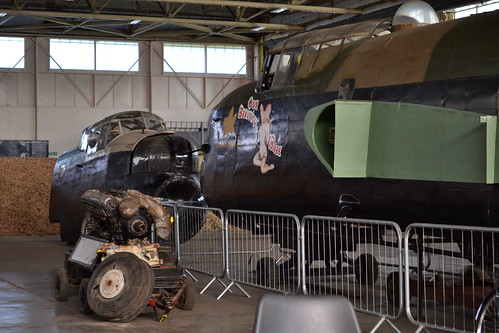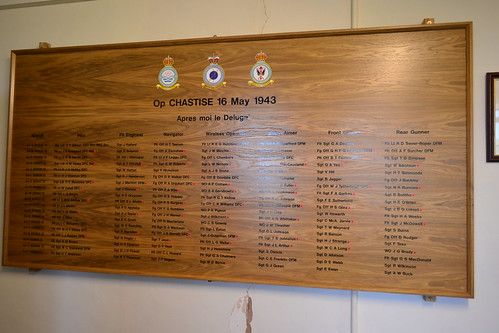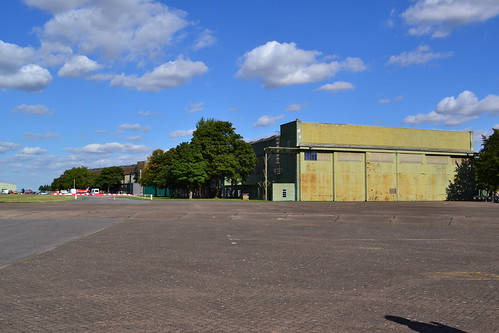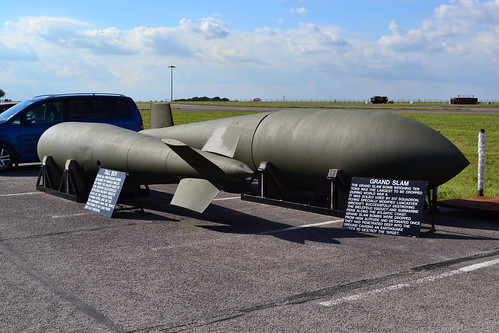Many in the aviation world were saddened and even shocked recently (24th July 2018) with the MOD’s announcement that RAF Scampton and RAF Linton-on-Ouse were to close, and the two sites sold off.
Whilst there seems to be little general objection to Linton-on-Ouse, there has been quite a backlash regarding the closure of RAF Scampton in Lincolnshire. Scampton is of course home to the RAF’s Red Arrows display team who moved in there around twenty years ago, but more famously, it was the home of 617 Squadron RAF otherwise known as ‘The Dambusters’ during the Second World War.
It is this that has primarily caused the huge backlash resulting in a petition and some quite heated social media ‘discussions’ over the closure. So what are the reasons behind such a move and what could the future hold for RAF Scampton?
Scampton has been under RAF ownership since the First World War, it is one of their oldest stations and has housed some 19 operational flying squadrons as well as a number of non-flying units during this time. The base was closed in 1996 and then again partially reopened for the storage and maintenance of aircraft, it was also at this point that it became home to the RAF’s Red Arrows. Currently the only other units stationed here are No.1 Air Control Centre and the Mobile Meteorological Unit.
No. 1 Air Control Centre was moved here from RAF Lossiemouth whilst upgrading work was undertaken on its site. They work in conjunction with, amongst others, RAF Boulmer to provide National and International air surveillance operations ready to deploy QRA Typhoons from either Lossiemouth or nearby Coningsby at a moments notice. They also provide support to international operations including those with the British Army and the Royal Navy.
The Mobile Meteorological Unit uses civilian operators (Reserves) to monitor weather conditions primarily for aviation related operations, but they can also assist in any operation where the weather may impact on the overall objective.
The Red Arrows (RAFAT) are perhaps the most famous of the world’s aircraft display teams, currently flying the BAE Hawk, in close formation flying displays that have spanned fifty-four years. The Red Arrows are famous the world over, with pilots undertaking a rigorous selection process and subsequent training programme, that sets them amongst the most elite pilots in the world.
These three units mean that there are around 600 people employed on the Scampton site, mainly armed forces personnel who will be moved with their various units to new postings when the move finally takes place. Some of these employees are civilian and live locally to the airfield.
The argument for closure.
The RAF has been under considerable pressure to reduce its costs whilst keeping a viable and effective force. The recent purchase of the F-35 Lightning to replace the now ageing Tornado, had a significant impact in the RAF’s overall budget. However, this was taken into consideration within the MOD’s strategy which aimed to reduce costs, streamline operations and reshape the RAF for the modern world. Notifications of these cuts were aired in the 2010 Strategic Defence & Security Review (SDSR) in which it was announced that the RAF would*1:
- Reduce its manpower force by around 5,000 personnel to 33,000 by 2015;
- Retain Tornado but remove Harrier from service in the
transition to a future fast jet force of Typhoon and JSF; - Not bring into service the Nimrod MRA4;
- Withdraw VC10 and the three variants of Tristar aircraft
from 2013 as part of the transition towards the more capable
A330 future strategic transport and tanker aircraft; - Withdraw the C-130 Hercules transport fleet 10 years earlier than planned to transition to the more capable and larger A400M;
- Withdraw the Sentinel surveillance aircraft once it is no longer required to support operations in Afghanistan;
- Rationalise the RAF estate (40% of which is over 50 years old)
Whilst much of this criteria has already been met, the estates management review has yet to take full effect. A series of reviews and assessments have been carried out by relevant Government bodies in conjunction with personnel from the MOD. The Better Defence Estates strategy 2016 (which is part of the Defence Estate Optimisation Programme) focuses on streamlining the MOD’s estates: land, bases and housing by 30% by 2040. Only by doing this, will the MOD meet its SDSR commitment, saving £3bn by 2040, allowing £4bn to be invested over the next 10 years on over 40 separate sites.
A further Government commitment is to generate 55,000 new private homes, some of which will be for armed forces personnel (Service Families Accommodation, SFA), but most will be released to private housing ventures. Much of the land owned by the MOD (which covers 1.8% of the UK land mass), and in particular the RAF, has huge building potential and is therefore prime building land.
So far, the MOD has disposed of nine military sites, with a further ninety-one earmarked for closure. This doesn’t include Scampton or Linton-on-Ouse, but does include: Swansea Airport, Newtownards Airfield, RAF Colerne, RAF Henlow, RAF Halton and the three American bases at Molesworth, Mildenhall and Alconbury (currently occupied by USAF personnel).
The cost of maintaining one of these sites, is not cheap, and a considerable amount of money was spent on Scampton following the 2010 review, to resurface the runway to allow both the Red Arrows to operate from here and to keep the base in operational status should other units be posted here later on. However, the infrastructure remains a pre World War II design, the buildings and hangars dating back to the expansion period of the 1930s (as do Linton-on-Ouse’s) and therefore completely inadequate for today’s modern Air Force. In his deliverance of the ‘Better Defence Estate’ statement, the Parliamentary Under-Secretary of State for Defence, Mr Tobias Ellwood, said “The disposal of the site would offer better value for money and, crucially, better military capability by relocating the units based there“.
Considering other aspects of Scampton, the Museum of RAF Fire Fighting*2 was told to vacate their premises in 2017, they have since found alternative accommodation in Gainsborough and aim to be up and running very soon. There was also a renewed effort to bring airshows back to Lincolnshire after the Waddington shows were stopped following upgrade at RAF Waddington. The first, and so far only attempt, at Scampton in September 2017, made a loss even though 50,000 visitors passed through the gates over the two-day period. This was a huge drop in figures however, compared to the 170,000 previously attained at Waddington. A planned event for 2018 was postponed until 2019, but no firm decision has been made about the future viability of this event.

Under restoration, two Lancaster front sections housed in the Grade II listed building. They may have to find new homes.
A further point to be considered is that of the local economy. Many argue that the base provides economic benefits to the local economy. Being only 600 personnel, this is quite a weak argument, unlike say Mildenhall that has 4,000 personnel contributing £219m (2013-14 figures) to its local economy.*3
So on the face of it, Scampton is ‘ideal’ for disposal, it is underused, located in an area already busy with aircraft activity (RAF Cranwell, RAF Waddington and RAF Coningsby are all nearby) and has an infrastructure suited for a private venture. The accommodation areas are mostly empty and those units based there are easily moved elsewhere, only the Red Arrows could prove a problem due to interference with other operational flying units.
The argument against closure.
However, that said, Scampton (more so than Linton-on-Ouse) has a huge historic value. Being a pre-war airfield it was vital for Bomber Command in the fight against Nazi Germany. Initially built with grass runways, these were improved upon with hard runways in the early war years, being extended to 10,000 feet later on in 1956, to be able to take the mighty Vulcan. This expansion led to extensive renovations including the re-sighting of the main Roman road (Ermine Street) that passes alongside the airfield. It is this extension that led to Scampton’s famous station badge of the bow and arrow. In 2016 Scampton celebrated its centenary and this year (2018) marks the 100th anniversary of the RAF.
The biggest factor in favour of keeping Scampton open are its historical, political and architectural aspects, the most famous being the presence of 617 (Dambusters) Sqn during the 1940s. A specialist squadron, formed under the leadership of Guy Gibson VC, DSO & Bar, DFC & Bar, who led the 133 airmen in nineteen Lancasters in the famous attack against the dams of the Rhur valley on May 16th, 1943. In memory of this historic event, a museum was opened up showcasing a number of artefacts from the Dambusters including Guy Gibson’s office. Gibson’s dog ‘Nigger‘ is also buried in the grounds of Scampton, outside of what was Gibson’s office and many of the offices used by the squadron are also open for pre-arranged visits.
There are of course a number of other historical aspects to this site. Airmen from Scampton were awarded a greater number of honours that any other bomber airfield, including two Victoria Crosses and a George Cross in 1940 alone. The first 2,000 lb bomb was delivered by aircraft based at Scampton, and numerous raids were undertaken from here including its participation on the first 1,000 bomber raid.
Post war and Scampton played a major part in the Cold War, an airfield housing the Vulcan, an aircraft capable of carrying and delivering the Blue Steel stand-off nuclear missile, one of only two airfields that could complete such a task. In order to complete this role, further T2 hangars were added, the dispersals were modified and additional ancillary buildings erected for fuelling and avionics.
The four ‘C’ type hangars now Grade II listed (1st December 2005 – List entry Number: 1391594) are the only listed buildings on site, the Blue Steel maintenance shed being demolished in March 2004, before listing was made. In fact over recent years, many unused buildings have been gradually demolished: the pre-war parachute stores, the main station workshop outbuildings, the Vulcan simulator, parts of the medical centre and the Warrant Officers’ Quarters are all included.
The main reason for the listing of these hangars is their ‘Legacy’ record, and includes the attached stores, workshops and offices. These ‘C’ type hangars were built in the period 1936-1937 by J. H. Binge of the Air Ministry’s Directorate of Works and Buildings, to drawing number 5043/36, and signify the airfield as a bomber airfield. The sacrifice by Bomber Command was immense, some 55,000 aircrew were killed in operations and many came from airfields in and around Lincolnshire. Thus these hangars, as listed buildings, stand as unofficial memorials to those who never came back and in particular to those of 617 Sqn who gave the ultimate sacrifice. As listed buildings, they cannot easily be demolished and therefore must be retained in any future development whatever that may be. Even with these modifications having taken place, the general layout of the airfield, the road networks and most buildings are still the pre-war expansion period designs, little has changed here since those days of the late 1930s when Britain was expanding it national network of airfields.
A review of Britain’s airfields by English Heritage, classified Scampton (and Linton-on-Ouse) “as one of most complete surviving of our Airfields with Runways and Perimeter tracks” comparable with RAF West Raynham, RAF Finningley, and RAF Waddington. It is a prime example of an expansion period model, being built under Scheme B of the period and only one of four to be so. The architectural designs of the buildings significant in themselves, being a mix of neo-Georgian and concrete within its non-dispersed site. The shape and design of Scampton (and Linton-on-Ouse) are unique to this period in time, square with straight roads and grassed / tree areas to hide the accommodation and technical areas.
A further point is that there have been numerous archaeological investigations and finds on and around the airfield itself. These include: Prehistoric remains, Roman remains (the Roman road traverses part of the airfield), Anglo-Saxon burial sites, Medieval sites, post-medieval and modern warfare sites (WWI & II) that remain buried. Many of these have yet to be fully investigated and mapped, but it is thought that there are strong links to all of these periods in time.
So what are the possible options?
These are certainly strong advocates for keeping the station alive, however, the question then arises does this warrant the huge expense of maintaining an operational airfield without service personnel being present? Does it warrant the use of an operational airfield just for the Red Arrows? Even if the RAF were to stay here, which unit(s) could be brought in and at what cost to other airfields? Many would argue not, and if the RAF / MOD are to meet their commitment to both a leaner more efficient Air Force and the SDSR, then on paper surely Scampton must close.
However, there are a number of options open when Scampton is closed. The worse scenario is that the entire site is sold to housing / industrial development. In such cases the historical aspect of Scampton could be lost, the hangars turned into industrial units and the airfield removed completely. This, if it were to happen, would no doubt cause a huge backlash from many in the aviation field including the RAF itself, and is unlikely (in my opinion) to happen.
Since the announcement of the 2010 SDSR the future of Scampton has been under considerable debate, with numerous studies being completed on behalf of the RAF and Lincolnshire County Council. On December 15th, 2011*4, Parliament were notified of the suggestion that Scampton could be closed by 2014 following the merger of No 1 Air Control Centre and the Control and Reporting Centre at RAF Kirton-in-Lindsey , which also closed as a result. Both these units would then move to RAF Coningsby, a move that was postponed following further investigations.
In October 2013, Lincolnshire County Council*5,6,7 carried out its own feasibility study following a request to investigate possible options for Scampton’s use in the future. The study looked at a range of options including combining civil and military aviation, a combined heritage and RAF base, and an expansion of the site to form a leisure complex. The report concluded that:
- The potential for “increased airspace use on a joint military / civilian basis was not feasible given the requirements of RAFAT. This effectively ruled out the option of developing the base as a commercial or leisure aerodrome alongside RAF use“.
- Many buildings were not being used and were therefore able to be demolished without any serious issues. Only the hangars were listed and would be more difficult to remove. Whilst there is currently a museum on site, this could be exploited establishing an “aviation focused attraction of national and international importance“. The cost of such a venture would be in the region of £80m, and it was thought that this would deliver an operating surplus based on “approximately 200,000 visitors per year“. These figures would make Scampton comparable with the National Space Centre at Leicester, and with a greater visitor rate than that of Lincoln Castle.
- It was also suggested the unused space could be turned into leisure activities “themed hotels” for example, and that any such activity would compliment the RAF’s expansion at Scampton should it go ahead. The entire process of this consultation was met with interest by the base commander, and at that time it was thought that Scampton would expand in terms of operational staff.
- In conclusion of the study, it was suggested that “The aviation heritage attraction would tell key stories relevant to Lincolnshire and its involvement in defence and aviation. It is likely to attract significant new visitors to the county, generating sufficient revenue to support long-term operational sustainability of the attraction, plus spend in the local economy.” It also suggested that “a major new aviation heritage attraction at RAF Scampton could sit alongside the current scale of military use and would be sufficiently flexible to work with a greater or lesser RAF presence.”
Whilst much of these points include an RAF presence of some sort, it would be flexible in nature until such time as it became self-sustaining. A further option is to develop Scampton retaining its historical features and infrastructure. Much of the married quarters area has already been sold off and is currently in private ownership. These utilise the actual married quarters and has proven quite successful. Further sections of this area are also being sold and developed and so the atmosphere of the site has changed little since its wartime days.
Recently we have seen similar ventures at both RAF Coltishall and RAF West Raynham, where the airfield buildings have been retained (including the hangars, watch office and many associated buildings including the aircraft pens) and the site turned into a working heritage site with small industrial units utilising the workshops and hangars, and private housing using the refurbished personnel homes.
The main argument against closing Scampton is one of cost, defence budgets are being cut and savings have to be made in the estates area. Scampton as it is, is not a viable airfield. However, its historical value is much higher, and any future decision and development needs to take this into account. If we are to retain our aviation heritage then serious consideration needs to be given to Scampton as a future development opportunity, themed hotels, museums of national importance or even a living history museum are all possible. What needs to be considered very carefully, is how that change is brought about. Lack of suitable knowledge or understanding of even small aspects of the site could degrade the overall venture, with important features degrading beyond safe use and poor managerial provision wasting an ideal opportunity in raising public awareness of the site’s true historical value.
Developments at both RAF Coltishall and RAF West Raynham have shown what good planning can do, creating something useful from a former airfield, whilst allowing for the preservation of its unique historic infrastructure.
This is clearly going to be a long and heated discussion, whether Scampton closes or not is only part of the debate, the crux of the matter being the historical value that it holds and what happens to the legacy it carries for all future generations.
Sources and Further Reading.
RAF Scampton was visited in Trail 30.
*1 Fact Sheet 8: Future Force 2020 – Royal Air Force. Published 19 October 2010, accessed 25/7/18.
*2 Museum of RAF Firefighting website, accessed 25/7/18.
*3 Figures from ‘Forces Network News’ website, accessed 25/7/18
*4 Memo to Parliament 15th November 2011
*5 Scampton – Appendix A – Scampton Aviation Heritage Consultancy Brief Final Version.pdf (RAF Scampton – Feasibility Study for an Aviation Heritage Attraction and
related Site Development Options – Brief – March 2013 ) accessed 25/7/18
*6 RAF Scampton Feasibility Study, 29 October 2013 to the Economic Scrutiny Committee on behalf of Executive Director for Communities Lincolnshire County Council. accessed 25/7/18
*7 Lincolnshire County Council Agenda item – RAF Scampton Feasibility Study Meeting of Economic Scrutiny Committee, Tuesday, 29th October, 2013 9.30 am (Item 34.)
The Development of Britain’s Airfields – AviationTrails
‘A Better Defence Estate’, November 2016, accessed 25/7/18.
News story “Defence Minister outlines progress on building a Better Defence Estate” Government news bulletin published 24th July 2018, by Ministry of Defence and The Rt Hon Tobias Ellwood MP
A Better Defence Estate, 24 July 2018, Volume 645, House of Commons, The Rt Hon Tobias Ellwood MP
Feasibility Study fr RAF Scampton, Purcell 2018 website.
Artech Designs Ltd. Design and Access Statement, April 2015
Historic England Website accessed 27/7/18




